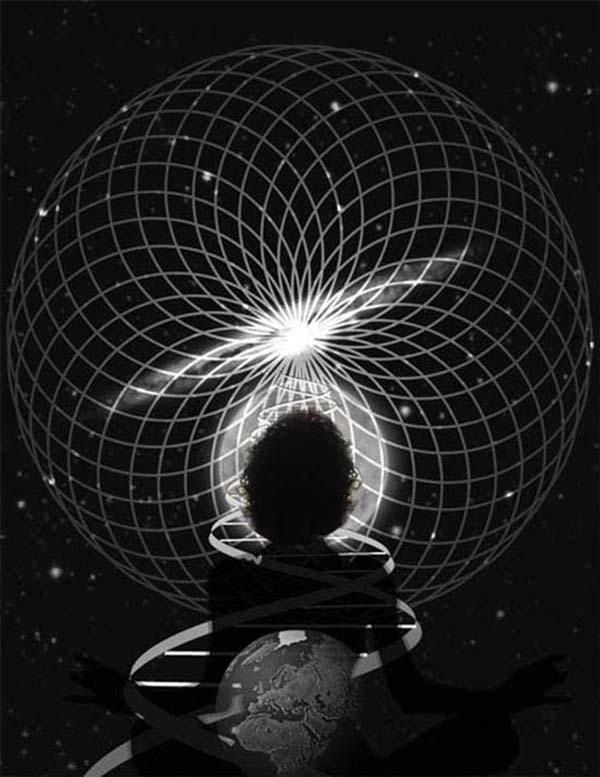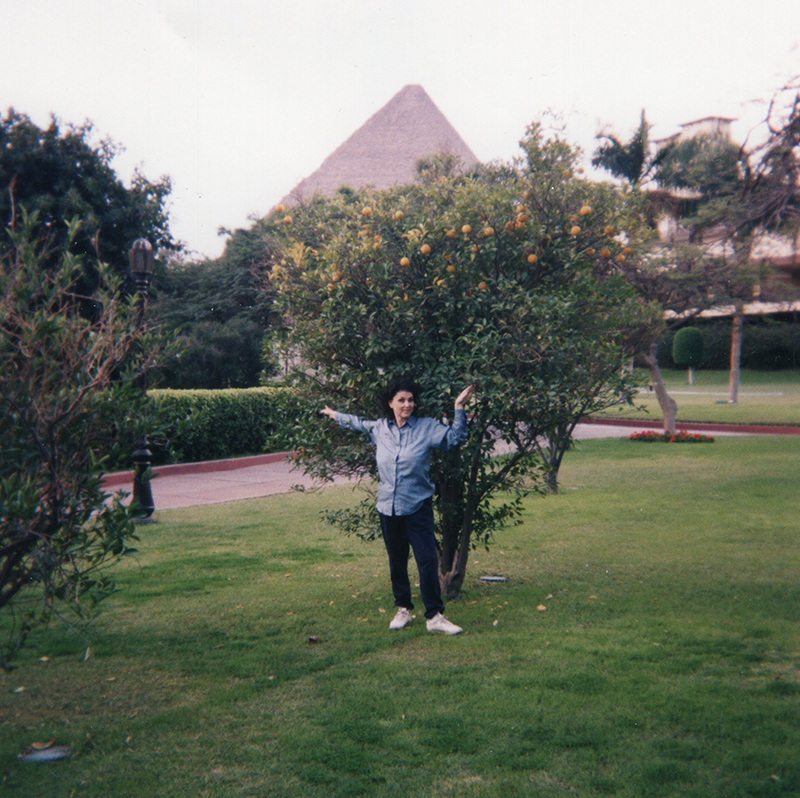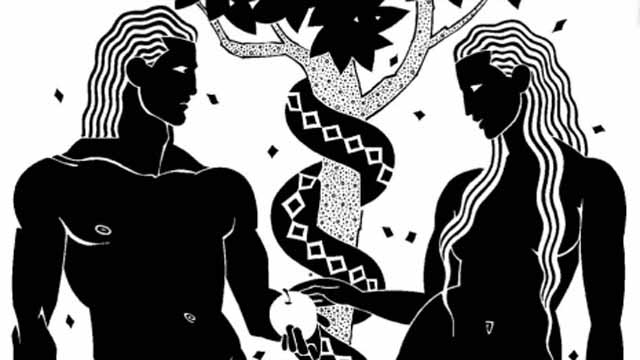
The Serpent in the Garden of Eden
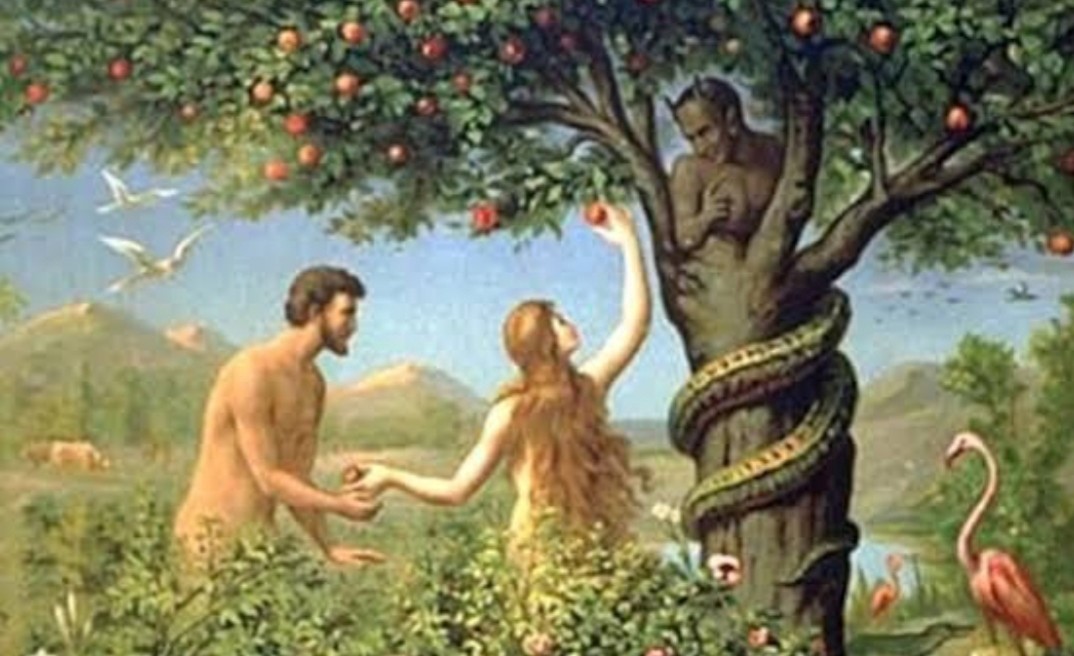
Gods or Aliens
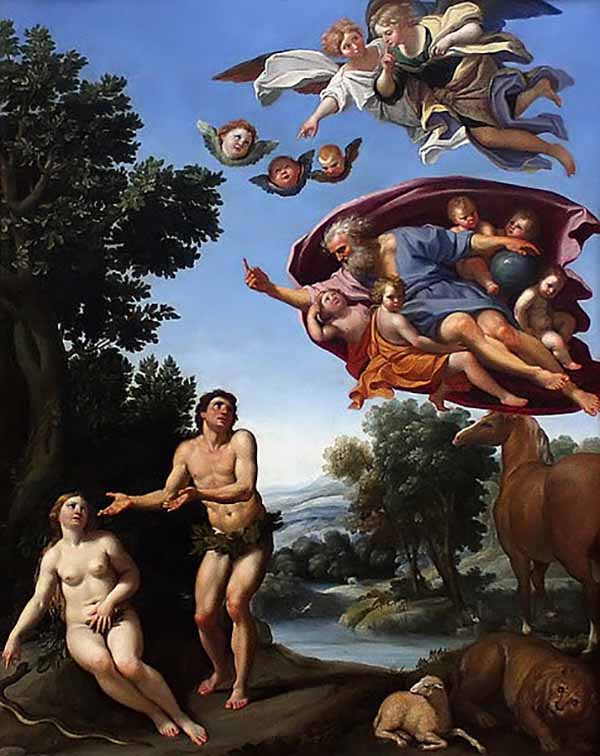

The Serpent in the Garden of Eden

Gods or Aliens

Eve is the feminine archetype - just as Adam represents the male. Eve carries the frequency of the goddess - creatrix on Earth - the high priestess - the source of creation. She is but a metaphor to help explain the polarity of our reality - the yin energies vs. the male yang energies - Adam. Much has been written about Eve and the metaphoric Garden of Eden. Our DNA genetic codes all trace back to one root source - the Seed of creation carried throughout time by the feminine aspects of this reality. That seed - Eve - Ovum is defined in the sacred geometry of creation and is part of each of us. Adam is the male component.
Adam and Eve were the first man and woman created by God according to the Bible and the Quran. The story is told in the Torah's book of Genesis, chapters 2 and 3, with some additional elements in chapters 4 and 5. The main story elements are the creation of man and woman; the temptation and the Fall; the expulsion from Eden; and the subsequent peopling of the world outside the Garden of Eden.
The narrative underwent extensive elaboration in later Abrahamic traditions, and modern textual scholarship continues to analysis the story's many layers, identifying, for example, parallels with Sumerian mythology. The story has provided many of the most important symbols in Western culture, including the Tree of Knowledge, the forbidden fruit, and the serpent as Satan, and has originated or reinforced some of Western Christianity's most important ideas, including the doctrine of original sin and the subordination of women.
The documentary hypothesis is a theory proposed by many historians and academics in the fields of linguistics and source criticism that the first five books of the Hebrew Bible, the Jewish Torah, are a combination of documents from different sources rather than authored by one individual. It had its origin in the interpretation that these five books contained many inconsistencies and apparent contradictions; they interpreted, for example, that Genesis 1 says man was created after the plants and animals, while Genesis 2 places the creation of man before the plants and animals.
The modern version of the hypothesis is that the chapters of Genesis which contain the Adam and Eve story are drawn from two originally separate texts or groups of texts, the Priestly source (sometimes also called the Ellohyst source) and the Jahwist source.
The Priestly source is responsible for chapter 1 and the first four verses of chapter 2, while the Jahwist provides the bulk of chapters 2 to 4. Despite coming first in Genesis, the Priestly (or "P") source is the more recent of the two. "Recent" in this context is purely a relative term: P is believed to have been composed at some period between the fall of the kingdom of Israel to the Assyrians in 722 BC, and the final conquest of Judah by the Babylonians in 586 BC, with a high probability of a date during the reign of king Josiah of Judah in the late 7th century BC. The Jahwist, or "J" source, is believed to have been composed in the kingdom of Judah before the fall of Israel (i.e., before 722 BC), but not before the late 8th century.
A separate source, the Book of Generations, provides chapter 5 and a brief linking phrase at Genesis 2:5. As the name indicates, this source is concerned exclusively with lists of names, in the form X begat Y. It is believed to be older than both J and P, and appears to have existed in various editions. Differences between these editions can be traced in confusions in the biblical genealogies; for example, chapter 4:17 to 18 and chapter 5:3 to 26 are apparently giving the same information, but the father of Lamech is named Methusael in chapter 4 and Methuselah in chapter 5. (Lamech was fathered by Methusael through Cain and Methusela through Seth. There is no contradictions between chapter 4:17-19 and 5:3-26.)
The "Generations of Adam," as Genesis 5 is called, uses a form of words implying the creation of more than a single man and woman: "Male and female he created them, and he blessed them and named them Man when they were created." The P source uses similar language: "God created man in his own image, in the image of God he created him; male and female he created them." Only J has an unambiguous single male and female. J (chapter 2) begins in the same way as the other two sources, with God taking "adamah" (dust) and fashioning "adam", the word translated as "man" in Genesis 1 and Genesis 5. Only towards the end of chapter 2, when the first humans are about to be expelled from the Garden, does J cease referring to "man" and start writing about "the man". In Jewish belief of the time of Christ this was taken as signifying a personal name, Adam, and this tradition was adopted into Christianity.
Only J has a separate name for Adam's companion, traditionally written as 'Eve' in English, from Hebrew 'chavva,' meaning simply living one, or life.
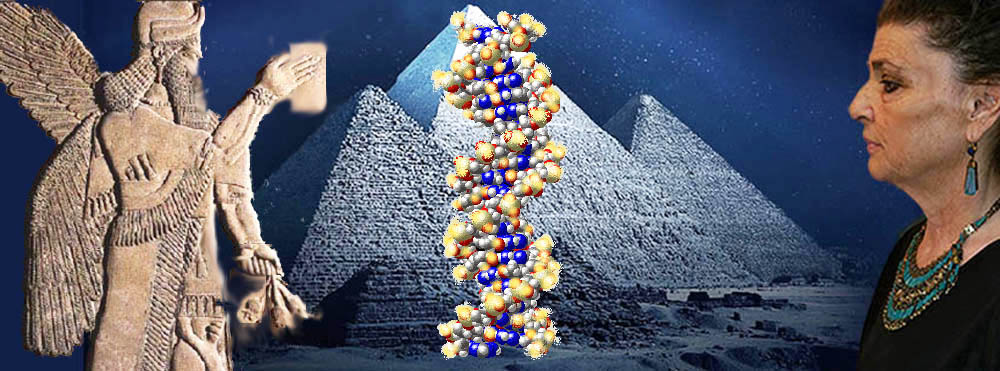
Tracing my bloodline to this Woman (Eve) 23andMe
Mitochondrial Eve is the name given by researchers to the woman who is the matrilineal most recent common ancestor for all living humans, from whom all mitochondrial DNA (mtDNA) in living humans is descended. Mitochondrial Eve is the female counterpart of the Y-chromosomal Adam, the patrilinear most recent common ancestor. She is believed by some to have lived about 150,000 years ago in what is now Ethiopia, Kenya or Tanzania. Her age is calculated based on the molecular clock technique of correlating elapsed time with observed genetic drift.
Naming Mitochondrial Eve after Eve of the Genesis creation story by Wilson, has led to some misunderstandings among the general public. A common misconception is that Mitochondrial Eve was the only living female of her time - she was not (indeed, had she been, humanity would have probably become extinct). Many women alive at the same time as Mitochondrial Eve have descendants alive today. However, only Mitochondrial Eve produced an unbroken line of mitochondria that persists today.
Imagine a family tree of all humans living today. Now imagine a line from each individual to their mother, and continue those lines from each of those mothers to their mothers, and so on. Going back through time their mitochondrial lineages will converge as sisters share the same mother. The further back in time one goes, the fewer mitochondrial ancestors of living humans there will be until only one is left - this is the latest common matrilineal ancestor of all the humans alive today, i.e. Mitochondrial Eve.
Now, going in the opposite direction of the family tree (from ancient times to today), imagine the same line, which now connects mothers to their daughters. Starting with the entire human population alive at some time in the past, lineages will become extinct as women die childless or only have male children. Eventually, only a single lineage remains, which is the same as before.
Mitochondrial Eve is the most recent common matrilineal (female-lineage) ancestor for mtDNA, not the most recent common ancestor (MRCA) of all humans. The MRCA's offspring have led to all living humans, but Mitochondrial Eve must be traced only through female lineage, so she is estimated to have lived much longer ago than the MRCA. While Mitochondrial Eve is thought to have been living around 150,000 years ago, the MRCA is estimated to have been living only a few thousand years ago.
Mitochondrial DNA - We know about Eve because of mitochondria organelles that are passed only from mother to offspring. Each mitochondrion contains Mitochondrial DNA (mtDNA). A comparison of DNA sequences from mtDNA in a population reveals a molecular phylogeny. Unlike mtDNA, which is outside the nucleus, genes in nuclear DNA become mixed because of genetic recombination, and therefore we can be statistically less certain about their origins. Diversity is magnified in mtDNA and population bottlenecks are particularly magnified (Wilson et al 1985).
Just as mitochondria are inherited matrilineally, Y-chromosomes are inherited patrilineally. Thus it is possible to apply the same principles outlined above to men. The common patrilineal ancestor of all humans alive today has been dubbed Y-chromosomal Adam. Importantly, the genetic evidence suggests the most recent patriarch of all humanity is much more recent than the most recent matriarch, suggesting that 'Adam' and 'Eve' were not alive at the same time.

The Seven Daughters of Eve is a book by Bryan Sykes that presents the theory of mitochondrial genetics to a general audience. Sykes explains the principles of genetics and human evolution, the particularities of mitochondrial genetics, and analyses of ancient DNA to genetically link modern humans to prehistoric ancestors.
Following the developments of mitochondrial genetics, Sykes traces back human migrations, discusses the out of Africa theory and refutes Heyerdahl's theory of the Peruvian origin of the Polynesians, opposing an Indonesian origin. He also describes the use of mitochondrial DNA in identifying the remains of Czar Nicholas II, and in assessing the genetic makeup of modern Europe.
The title of the book comes from one of the principal achievements of mitochondrial genetics, which is the classification of all modern humans into mitochondrial haplogroups. Each haplogroup is defined by set of characteristic mutations on the mitochondrial genome, and can be traced along a person's maternal line to a specific prehistoric woman. Sykes refers to these women as "clan mothers", though these women did not all live concurrently, and indeed some "clan mothers" are descended from others.
All these women in turn shared a common ancestor, the so-called Mitochondrial Eve. Sykes claims there are seven mitochondrial lineages for modern Europeans (though others put the number at 11 or 12) and he therefore speaks of the "Seven Daughters of Eve". The number of mitochondrial lineages for the entire human population (rather than just for Europeans) is considerably larger. The second half of the book is spent on a series of fictional narratives, written by Sykes, describing his creatives guesses about the lives of each of these seven "clan mothers". This latter half generally met with mixed reviews in comparison with the first part.
Mitochondrial Haplogroups in The Seven Daughters of Eve
Mitochondrial Eve is sometimes referred to as African Eve, an ancestor who has been hypothesized on the grounds of fossil as well as DNA evidence. According to the most common interpretation of the mitochondrial DNA data, the titles belong to the same hypothetical woman. Family trees (or "phylogenies") constructed on the basis of mitochondrial DNA comparisons show that the living humans whose mitochondrial lineages branched earliest from the tree are indigenous Africans, whereas the lineages of indigenous peoples on other continents all branch off from African lines. Researchers therefore reason that all living humans descend from Africans, some of whom migrated out of Africa to populate the rest of the world. If the mitochondrial analysis is correct, then because mitochondrial Eve represents the root of the mitochondrial family tree, she must have predated the exodus and lived in Africa. Therefore many researchers take the mitochondrial evidence as support for the "single-origin" or Out-of-Africa model.
Since phylogeny has theoretical as well as practical (computational) limitations, it is hard if not impossible to find the best tree to match experimental data, and therefore room is left for discussion. Critics of the "African genesis" model argue that the mitochondrial evidence can be explained by natural selection acting on a single gene. This explanation is compelling because nuclear genes do not show the same "evidence" that the mitochondrial gene does. Moreover, some trees associate Eve most closely to the indigenous peoples of Asia. As of 2003 the current debate focuses more on questions of dating an event that is generally considered proven. This will continue to prove futile because of natural selection.
The strongest support that mitochondrial DNA offers for the African-origin hypothesis may not depend on trees. One finding not subject to interpretation is that the greatest diversity of mitochondrial DNA sequences exists among Africans. This diversity would not have accumulated, researchers argue, if humans had not been living longer in Africa than anywhere else. Yet, this too proves to be a mixed blessing of "support" for the Eve theory since the same relative diversity is explained if more people lived in African than in other regions - an interpretation of the past that all evolutionary models accept, even those that contradict the Eve theory such as Multiregional evolution.
In Sumerian mythology the senior gods spent their time in leisure, while the junior gods labored at digging the channels of the rivers and other tasks. Eventually the junior gods rebelled and threatened to overturn the heavenly order. The senior god Enki therefore fashioned the first men from clay, mixed with spittle and the blood of a slain god, so that men could work and the gods could rest. Originally Enki made seven men and seven women, but the numbers of mankind soon multiplied.
In another Sumerian myth the goddess Ninhursag created a beautiful garden full of lush vegetation and fruit trees, called Edinu, in Dilman, the Sumerian earthly Paradise, a place which the Sumerians believed to exist to the east of their own land, beyond the sea. Ninhursag charged Enki, her lover, with controlling the wild animals and tending the garden, but Enki became curious about the garden and his assistant, Adapa, selected seven plants and offered them to Enki, who ate them. (In other versions of the story he seduced in turn seven generations of the offspring of his divine marriage with Ninhursag).
This enranged Ninhursag, and she caused Enki to fall ill. Enki felt pain in his rib, which is a pun in Sumerian, as the word "ti" means both "rib" and "life. The other gods persuaded Ninhursag to relent. Ninhursag then created a new goddess named Ninti, (a name made up of "Nin", or "lady", plus "ti", and which can be translated as both Lady of Living and Lady of the Rib), to cure Enki. Ninhursag is known as mother of all living creatures, and thus holds the same position as Eve. The story has a clear parallel with Eve's creation from Adam's rib, but given that the pun with rib is present only in Sumerian, linguistic criticism places the Sumerian account as the more ancient.
By the Babylonian era, Enki's place was taken by Adapa Uan (the Oannes of Berossus), a human created by Enki as advisor to the first king of Enki's city of Eridu. A 14th century BC tablet refers to Adapa as the seed of humankind. One myth recounts that Adapa broke the wings of the wind in anger at being disturbed while fishing, and was called to the heavens to answer for doing so. He was warned by Enki to apologise for his actions, but not to touch the food, in case it had been poisoned in revenge. The gods, impressed by his penitence, set the food and drink of immortality before him, but Adapa heeded Enki's warning and refused the food, thus missing out on immortality. The god who offered the food and drink of immortality was the wily serpent-god Ningishzida. In the Biblical account the serpent offers knowledge, but he also says to Eve that she shall not die.
As the food and drink of the gods originated on earth, somewhere on earth must lie the source of the food and drink of immortality, a Tree of Life. In the biblical account the food is consumed, not rejected, and the couple are punished by being expelled from the garden. Thus any derivation of the biblical account from Sumerian and Babylonian mythology involves the confusion of the tales of Adapa and Enki. Such a conflation may have been influenced by a story preserved in the prologue of Gilgamesh, Enkidu and the Underworld. In this tale, the goddess Inanna, who gains knowledge of sex by descending to earth and eating from various plants and fruits, transplants the huluppu tree from the Euphrates to her own garden, but a wicked serpent made its nest amongst the roots of the tree. This tale connects the serpent to the garden, and with the presence of Inanna, the theme of lust. Moving the story of Enki's rib to the start of the Biblical story would allow the failure to gain immortality to be seen as punishment for eating the fruit.
Despite popular belief to the contrary, men and women have the same number of ribs (twelve pairs). The misconception that they do not is probably due to the verse at Genesis 2:20, "The Lord God caused the man to fall into a deep sleep; and while he was sleeping, he took one of the manÕs ribs and closed up the place with flesh. Then the Lord God made a woman from the rib he had taken out of the man, and brought her to the man."
If this verse was not attempting to explain a non-existent difference between males and females, what was it trying to do? One theory is based on the Sumerian myth of Ninhursag and Enki. Ninhursag was angry with Enki and caused him to fall ill. Enki felt pain in his rib "ti", which in Sumerian means both "rib" and "life", and began to die. Ninhursag relented, and created a new goddess named Ninti, ("Nin", or "lady", plus "ti"), which can be translated as both Lady of Living and Lady of the Rib, to cure Enki. Given that the pun of "life" with "rib" is present only in Sumerian, this hypothesis, based on linguistic criticism, places the Sumerian account as the more ancient.
In the Sibylline Oracles, the name Adam is explained as a notaricon composed of the initials of the four directions; anatole (east), dusis (west), arktos (north), and mesembria (south). The Jews had their own acrostic interpretation of the name Adam. In the 2nd century CE, Rabbi Yohanan used the Greek technique of notarichon to explain the name as the initials of the words afer, dam, and marah, being dust, blood, and gall.
According to the Torah (Genesis 2:7), Adam is said to have been formed by God from "dust from the earth"; in the Talmud (Tractate Sanhedrin 38b) of the first centuries of the Christian era he is, more specifically, described as having initially been a golem kneaded from mud. (cf Prometheus) In the Torah, God is described, at Genesis 1:26, as breathing the breath of life into the nostrils of the first man, and this is usually interpreted in Judaeo-Christian circles as having brought life immediately to the first man.
At this point, in the Torah, God is described as causing a deep sleep to fall upon Adam, and removing part of his body, usually interpreted as a rib (though a more literal translation is non-specific, referring to "side"). Once a matron asked Rabbi Jose (Talmud), "Why did God steal a rib from Adam?" "Steal?" replied the Sage. "If one were to take away from your house an ounce of silver, and give you in return a pound of gold, that would not be stealing from you." "But," persisted the matron, "what need was there for secrecy?" "It was surely better," replied R. Jose, "to present Eve to Adam when she was quite presentable, and when no traces of the effects of the operation were visible".
Even in ancient times, the presence of two distinct accounts was noted, and regarded with some curiosity. The first account says male and female God created them, which has been assumed by critical scholars to imply simultaneous creation, whereas the second account states that God created Eve from Adam's rib because Adam was lonely. Thus to resolve this apparent discrepancy, mediaeval rabbis suggested that Eve and the woman of the first account were two separate individuals.
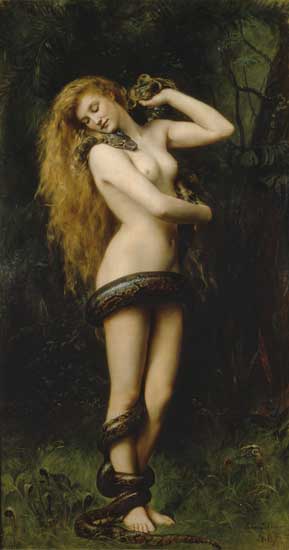
Lilith
Preserved in the Midrash, and the mediaeval Alphabet of Ben Sira, this rabbinic tradition held that the first woman refused to take the submissive position to Adam in sex, and eventually fled from him, consequently leaving him lonely. This first woman was identified in the Midrash as Lilith, a figure elsewhere described as a night demon.
The word liyliyth can also mean "screech owl", as it is translated in the King James Version of Isaiah 34:14, although some scholars take this to be a reference to the same demonic entity as mentioned in the Talmud.
In the Talmud, Adam is said to have separated from Eve for 130 years, during which time his ejaculations gave rise to ghouls, and demons. Elsewhere in the Talmud, Lilith is identified as the mother of these creatures. The demons were said to prey on newborn males before they had been circumcised, and so a tradition arose in which a protective amulet was placed around the neck of newborns. Traditions in the Midrash concerning Lilith, and her sexual appetite, have been compared to Sumerian mythology concerning the demon ki-sikil-lil-la-ke, by scholars who postulate an intermediate Akkadian folk etymology interpreting the lil-la-ke portion of the name as a corruption of lilitu, literally meaning female night demon.
The Alphabet of Ben Sira Midrash goes even further and identifies a third wife, created after Lilith deserted Adam, but before Eve. This unnamed wife was purportedly made in the same way as Adam, from the "dust of the earth", but the sight of her being created proved too much for Adam to take and he refused to go near her. It is also said that she was created from nothing at all, and that God created into being a skeleton, then organs, and then flesh. The Midrash tells that Adam saw her as "full of blood and secretions," suggesting that he witnessed her creation and was horrified at seeing a body from the inside out. Ben Sira does not record this wife's fate. She was never named, and it assumed that she was allowed to leave the Garden a perpetual virgin, or was ultimately destroyed by God in favor of Eve, who was created when Adam was asleep and oblivous. It should be noted here, that both Lilith and the Second Wife are free from any curse of the Tree of Knowledge, as they left long before the event occurred.
Genesis does not tell for how long Adam and Eve were in the Garden of Eden, but the Book of Jubilees states that they were removed from the garden on the new moon of the fourth month of the 8th year after creation (Jubilees 3:33); other Jewish sources assert that it was less than a day. Shortly after their expulsion, Eve brought forth her first-born child, and thereafter their second - Cain and Abel, respectively.
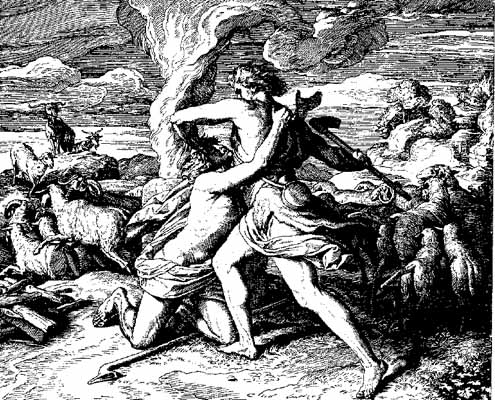
Another Jewish tradition---also used to explain "male and female He created them" line, is that God originally created Adam as a hermaphrodite[Midrash Rabbah - Genesis VIII:1], and in this way was bodily and spiritually male and female. He later decided that "it is not good for [Adam] to be alone," and created the separate beings of Adam and Eve, thus creating the idea of two people joining together to achieve a union of the two separate spirits.
Only three of Adam's children (Cain, Abel, and Seth) are explicitly named in Genesis, although it does state that there were other sons and daughters as well (Genesis 5:4). In Jubilees, two daughters are named - Azura being the first, and Awan, who was born after Seth, Cain, Abel, nine other sons, and Azura. Jubilees goes on to state that Cain later married Awan and Seth married Azura, thus, accounting for their descendants. However, according to Genesis Rabba and other later sources, either Cain had a twin sister, and Abel had two twin sisters, or Cain had a twin sister named Lebuda, and Abel a twin sister named Qelimath. In the Conflict of Adam and Eve with Satan, Cain's twin sister is named Luluwa, and Abel's twin sister is named Aklia.
Other pseudepigrapha give further details of their life outside of Eden, in particular, the Life of Adam and Eve (also known as the Apocalypse of Moses) consists entirely of a description of their life outside Eden. As the first man, Adam was traditionally a significant figure to whom was attributed prophecy and wisdom.
After Cain killed Abel, and was cursed to wander, Adam and Eve conceived a third child named Seth, who, with Cain, gave rise to the two family lines of the Generations of Adam.
According to the Bible, Adam finally died at the age of 930 years, the traditional Jewish view being that he and Eve are currently buried in the Cave of Machpelah, in Hebron.
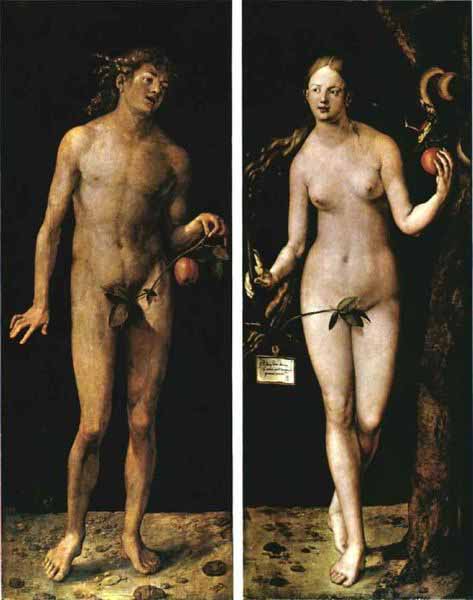
Adam and Eve
Some branches of Christianity fully accept the tradition of Adam and Eve as portrayed in the Bible, and although some hold various views expressed in the Pseudepigrapha, they do not accept the later Jewish Midrash.
The story of Adam and Eve forms the basis for the doctrine of original sin, a doctrine that is held as true by many branches of Christianity, but is not shared by the Orthodox or Congregationalist churches, nor by Judaism nor The Church of Jesus Christ of Latter-day Saints. "Sin came into the world through one man and death through sin, and so death spread to all men because all men sinned," said St Paul in his Epistle to the Romans, writing in Greek about 58 AD.
St Paul was not being true to the Hebrew of Genesis, which nowhere mentions the words "sin" and which does not say that Adam was punished with death. (Adam's transgression in Genesis 3 is disobedience, not sin, and he is expelled from Eden not in order to die, but so that he may not eat of the Tree of Life and become immortal).
St Augustine of Hippo (354-430 AD), working with a Latin mistranslation of the epistle, understood Paul to have said that Adam's sin was hereditary: "Death passed upon (i.e. spread to) all men because of Adam, [in whom] all sinned". Original sin, the concept that man is born in a condition of sinfulness and must await redemption, while founded on a forced reading of Genesis followed by an exegesis based on a mistranslation, nevertheless became a cornerstone of Christian theological tradition, primarily in Western-rite churches.
Over the centuries, a system of uniquely Christian beliefs has developed from the Adam and Eve story. Baptism, which predates Christianity has become understood as a means of washing away the stain of hereditary sin. Additionally, the serpent that tempted Eve was interpreted by some to have been Satan, although there is no mention of this identification in the Torah. In fact, Genesis does not even hint at any of these readings, and their observance by many Christians has marked the religion's radical break from its parent.
Because Eve had tempted Adam to eat of the fatal fruit, some early Fathers of the Church held her and all subsequent women to be the first sinners, and especially responsible for the Fall. "You are the devil's gateway," Tertullian told his female listeners in the early 2nd century, and went on the explain that they were responsible for the death of Christ: "On account of your desert - that is, death - even the Son of God had to die."
In 1486 the Dominicans Kramer and Sprengler used similar tracts to justify the Malleus Maleficarum ("Hammer of the Witches") that led to three centuries of persecution of "witches".
Eastern Orthodox tradition holds that the sword placed at the entrance to Paradise to prevent humankind from returning to the Garden was removed once Jesus was born.
While the Gnostics used scriptural texts as teaching devices, rather than viewing them to be literal accounts genuinely written by early patriarchs, this was the converse of what was true of what became official Christianity. The Gnostic's Nag Hamadi text "Apocalypse of Adam", for instance contains the account of the enlightenment Adam received, for which certain angels became jealous. The "Testament of Adam", for example takes a further step to produce a faked ancient prophecy, of events that had supposedly already occurred by the time it was published.
In certain forms of Christian Gnosticism the creation of Adam as Protanthropos - the original man, had a very important place. The Apocalypse of Adam suggests that Adam and Eve were originally conjoined in a single androgynous being both male and female and greater than the eternal angels and higher than Samael, the God of the Aeon and Powers that had created them. This seems to be what Irenaeus (I, xxix, 3) refers to when he states that the Aeon Autogenes (self-created Aeon) creates a true and perfect human Anthrpos, also called Adamas, who has "Perfect Knowledge. In wrath of Samael, the God of the Aeon then separated Adam from Eve, causing their superior knowledge of God to flee from them.
The Perfection of the Protanthropos is also sometimes seen as a result of a non material emanation from God, called the Son of God and seen as the prefigurement for the appearance of Jesus, who, even in Conventional Christian literature is often referred to as "The Second Adam".
According to the Naassenes it is only when Adam and Eve are separated that they "sink" into material form. The Genesis verse, that "according to the image of God he made them, male and female he made them", implied that the first account of the creation of man and woman, according to Theodotus (c.160 CE), that both man and God were anthropogynous beings, later separated by God, the Father/Mother.
As Pagels shows "The followers of Valentinus suggested that the Mother herself had encouraged the God of Israel to think he was acting autonomously, but as they explain, "It was because he was foolish and ignorant of his Mother that he said, 'I am (the only) God; there is no-one beside me'. (p.69)
In the Secret Book of John, the creator of Adam and Eve, when he said: 'I am a jealous God and there is no other God besides me.' But by announcing this he indicated to the angels ... that another God does exist; for if there were no other one, of whom would he be jealous?... Then the Mother began to be distressed."
Eve too has different roles within Gnosticism. For example she is often seen as the embodiment of the supreme feminine principle, called barbelo, barbeloth, or barthenos. As such she is equated with the Light-Maiden of Sophia (Wisdom), creator of the word (Logos) of God, the "thygater tou photos" or simply the Virgin Maiden, "parthenos". Again, in conventional Christianity, this is a prefigurement of Mary, also sometimes called "the Second Eve". In other Gnostic texts, such as The Hypostasis of the Archons, (The Reality of the Rulers), the Pistis Sophia is equated with Eve's daughter, Norea, the wife of Seth.
As a result of such Gnostic beliefs, especially amongst Marcionites, women were considered equal to men, being revered as prophets, teachers, travelling evangelists, faith healers, priests and even bishops.
Gnostics seem to have taken the Marcionite belief that the Wrathful Yahweh of the Torah and the loving Father of Christianity were two separate divinities. In their book "The Origin of the World" for instance it states:-
Now when the heavens had consolidated themselves along with their forces and all their administration, the prime parent became insolent. And he was honored by all the army of angels. And all the gods and their angels gave blessing and honor to him. And for his part, he was delighted and continually boasted, saying to them, "I have no need of anyone." He said, "It is I who am God, and there is no other one that exists apart from me." And when he said this, he sinned against all the immortal beings who give answer. And they laid it to his charge.
Then when Pistis saw the impiety of the chief ruler, she was filled with anger. She was invisible. She said, "You are mistaken, Samael," (that is, "blind god"). "There is an immortal man of light who has been in existence before you, and who will appear among your modelled forms; he will trample you to scorn, just as potter's clay is pounded. And you will descend to your mother, the abyss, along with those that belong to you.
Gnostic accounts also turned the identification of the serpent with Satan on its head, and the serpent was seen as the hero, particularly to Ophites, who was trying to help the couple gain knowledge to defeat evil Samael, whom the Gnostics saw as the jealous demiurge of the creation.
There is also the tradition that Satan refused to bow to Adam as a result of his exclusive love of God, and felt that bowing to humankind was a form of idolatry. This tradition informs the treatment of Satan in some forms of Christian gnosticism.
More extended versions of the fall of Satan exist in which he leads a divine war, which, while in works such as the Book of Enoch is recorded as being in heaven after Satan turns away from God.
The early Islamic commentator Muhammad ibn Jarir al-Tabari records that when it came time to create Adam, God sent Gabriel (Jibril), then Michael (Mika'il), to fetch clay from the earth; but the earth complained, saying I take refuge in God from you, if you have come to diminish or deform me, so the angels returned empty-handed. Tabari goes on to state that God responded by sending the Angel of Death, who took clay from all regions, hence providing an explanation for the variety of appearances of the different races of mankind.
According to Tabari's account, after receiving the breath of God, Adam remained a dry body for 40 days, then gradually came to life from the head downwards, sneezing when he had finished coming to life, saying All praise be to God, the Lord of all beings[citation needed]. Having been created, Adam, the first man, is described as having been given dominion over all the lower creatures, which he proceeds to name. As one of the people to whom God is said to have spoken to directly, Adam is seen as a prophet in Islam.
At this point, Adam takes a prominent role in Islamic traditions concerning the fall of Satan, which is not recorded in the Torah, but in the Book of Enoch which is used in Oriental Orthodox churches. In these, when God announces his intention of creating Adam, some of the angels express dismay, asking why he would create a being that would do evil. Teaching Adam the names reassures the angels as to Adam's abilities, though commentators dispute which particular names were involved; various theories say they were the names of all things animate and inanimate, the names of the angels, the names of his own descendants, or the names of God.
When God orders the angels to bow to Adam one of those present, Satan (Iblis in Islam, regarded as a jinn rather than an angel, and hence avoiding questions about angels having free will), refuses due to his pride, and is summarily banished from the heavens. Liberal movements within Islam have viewed God's commanding the angels to bow before Adam as an exaltation of humanity, and as a means of supporting human rights, others view it as an act of showing Adam that the biggest enemy of humans on earth will be their ego.
More extended versions of the fall of Satan also exist in works such as that of Tabari, and the Shia commentator al-Qummi. In these explanations Iblis is sent against the jinn, who had angered God by sin and fighting. In such versions where Satan leads the battle on God's behalf, rather than his own, it is the pride and conceit resulting from his victory which results in his expulsion, since pride is seen as a sin. Islamic traditions further record that, in vengeful anger, Iblis promises God that he will lead as many humans astray as he can, to which God replies that it is the choice of humans - those who so desire will follow Satan, while those who so desire will follow God.
�Eve is not mentioned by name in the Qur'an, she is nevertheless referred to as Adam's wife. In fact, although her creation is not recounted in the Qur'an, Tabari recounts the biblical tale of her creation, stating that she was named because she was created from a living thing (her name means living). The torah gives an etymology for woman, or rather the Hebrew equivalent (ish-shah), stating that she should be called woman since she was taken out of man (ish in Hebrew). The etymology is regarded as implausible by most semitic linguists. Interestingly, Quran blame both, Adam and Eve for eating the forbidden fruit. Hence, from Islamic point of view, this event doesn't pose a problem of women inferiority to men intrinsically.
Al-Qummi records the opinion that Eden was not entirely earthly, and so, having been sent to earth, Adam and Eve first arrived at mountain peaks outside Mecca; Adam on Safa, and Eve on Marwa. In this Islamic tradition, Adam remained weeping for 40 days, until he repented, at which point God rewarded him by sending down the Kaaba, and teaching him the hajj. Other Islamic traditions hold that Adam was moved to Sri Lanka, as the next best thing to Eden, and, viewing Adam as having been a giant, human size having shrunk drastically before the great flood, Adam's Peak is said to contain his giant footprint.
The Qur'an also describes the two sons of Adam (named Qabil and Habil in Islamic tradition, but not mentioned by name in the Qur'an) that correspond to Cain and Abel.
However, some Islamic scholars, do believe that Adam was the first prophet to the humans rather being the first human, they have strong references from Quran guiding to that creation was rather a plural action, as well as, Adam was sent to already created humans who where committing lot of sins to teach them how to be good and well representative of God on the earth.
Many modern Christian and Jewish scholars consider Adam and Eve as an example of religious myth focusing on the teaching of perceived fundamental truths. In their interpretation, the story's purpose is to convey the importance and truth of sin and human rebellion in their traditions, regardless of historical accuracy. All, some, or none of the actual events of the narrative may have actually happened, or been embellished.
Adam and Eve are often considered as real historical people, as Genesis 5:4 records Adam within a genealogy. In the New Testament, Paul references Adam and Eve many times, especially contrasting Adam with Jesus where Paul writes "just as sin entered the world through one man." This seems to support a historical Adam as many theologians interpret Adam's sin as a historical event that changed humankind. However, Paul could be merely using the myth as a teaching method. Others view Adam and Eve as metaphorical for every person when they first sin and God seeks them out. Those who hold this view point out that adam can also be translated humankind.
The Age of Reason prompted Christians to interpret the Bible as strict history rather than historical myth; William Whiston was one such early scholar. James Ussher calculated Adam and Eve's life at approximately 4,000 BC, basing on the Genealogies of Genesis and Table of Nations.
In modern times, with the advent of archaeological discoveries, the theory of evolution, and genetic science, Christians believing in the historicity of Adam and Eve were challenged. Many denominations have rejected the historicity of Adam and Eve; others have retained it, including (at least officially) the Church of Jesus Christ of Latter-day Saints (Mormons), the Roman Catholic Church and evangelicals.
Early Renaissance artists used the theme of Adam and Eve as a way to represent female and male nudes. Later, the nudity was objected to by more modest elements, and fig leaves were added to the older pictures and sculptures, covering their genitals. The choice of the fig was a result of Mediterranean traditions identifying the unnamed Tree of the Knowledge of Good and Evil as a fig tree, and since figs leaves were actually mentioned in Genesis as being used to cover Adam and Eve's nudity.
Another issue was whether they should be depicted with navels. Since they were created fully grown, and did not develop in a uterus, they would not have had the umbilical scars possessed by all born humans. However, paintings without navels looked unnatural.
In Northern Europe, the unnamed "Forbidden fruit" became considered a form of apple, because of a misunderstanding of the Latin "malum", where malum as an adjective means evil, but as a noun means apple. The larynx in the human throat, noticeably more prominent in males, was consequently called an Adam's apple, from a notion that it was caused by the forbidden fruit sticking in Adam's throat as he swallowed, and the name has stuck.
Some Slavonic texts state that the "forbidden fruit" was actually the grape, that was later changed in its nature and made into something good, much as the serpent was changed by losing its legs and speech. Read more ...
